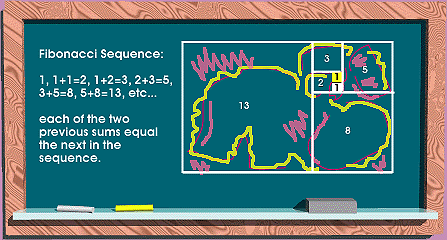Fibonacci Sequence

Some artists choose to construct a framework as a guide to organize their compositions. Geometry provides stable and predictable rhythms that help an artist to place shapes, values, and other elements.
Fibonacci Numbers
The Fibonacci Sequence is a numerical convention that can be translated into many forms. It has been used in mathematics, architecture, poetry, music, art, and even as a system for predicting the growth of the stock market. It was developed by man named Leonardo of Pisa. Leonardo called himself Fibonacci which is a derivation from a Latin phrase "filius Bonacci" or "son of Bonacci." Even though he was originally from Italy, Fibonacci was educated in Bougia, North Africa and learned the "Hindu-Arabic" mathematical system from Moorish teachers. He saw advantages to this system and was one of the individuals responsible for introducing it into Europe.
About the Illustration
The composition that I have illustrated above, shows the Sequence applied in a spiral pattern. Starting with 1 x 1 square (yellow), above a 1 x 1 square (white), then bounded by a 2 x 2 square, then a 3 x 3 square, a 5 x 5 square, etc... spiraling outward from center. The abstracted figure is applied to the composition.
Hint
When designing a drawing, divide up the paper into sections based on this principle, then place your subjects into these divisions. Don't follow the lines so exactly that they are evident, but allow for some natural flow to extend beyond the boundaries that you have drawn. You'll find this effective in making your drawings more interesting.
